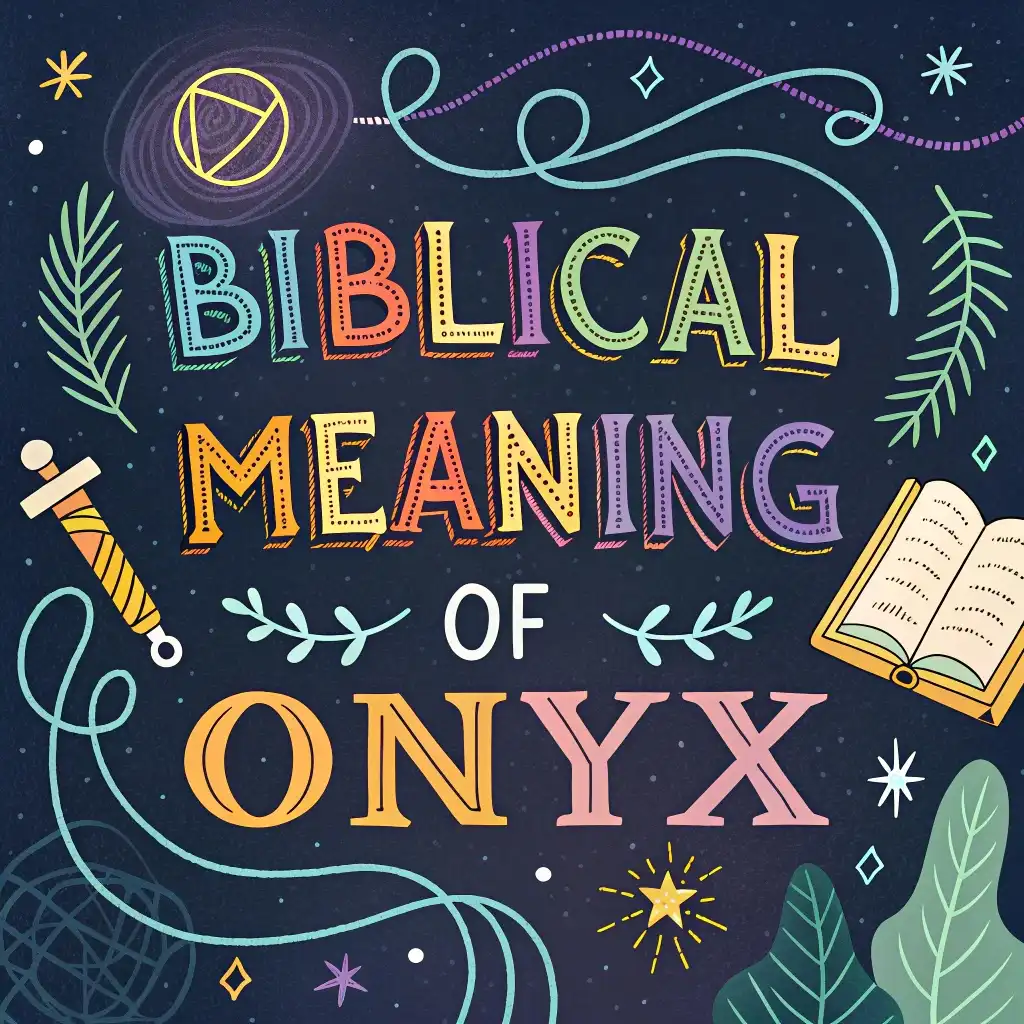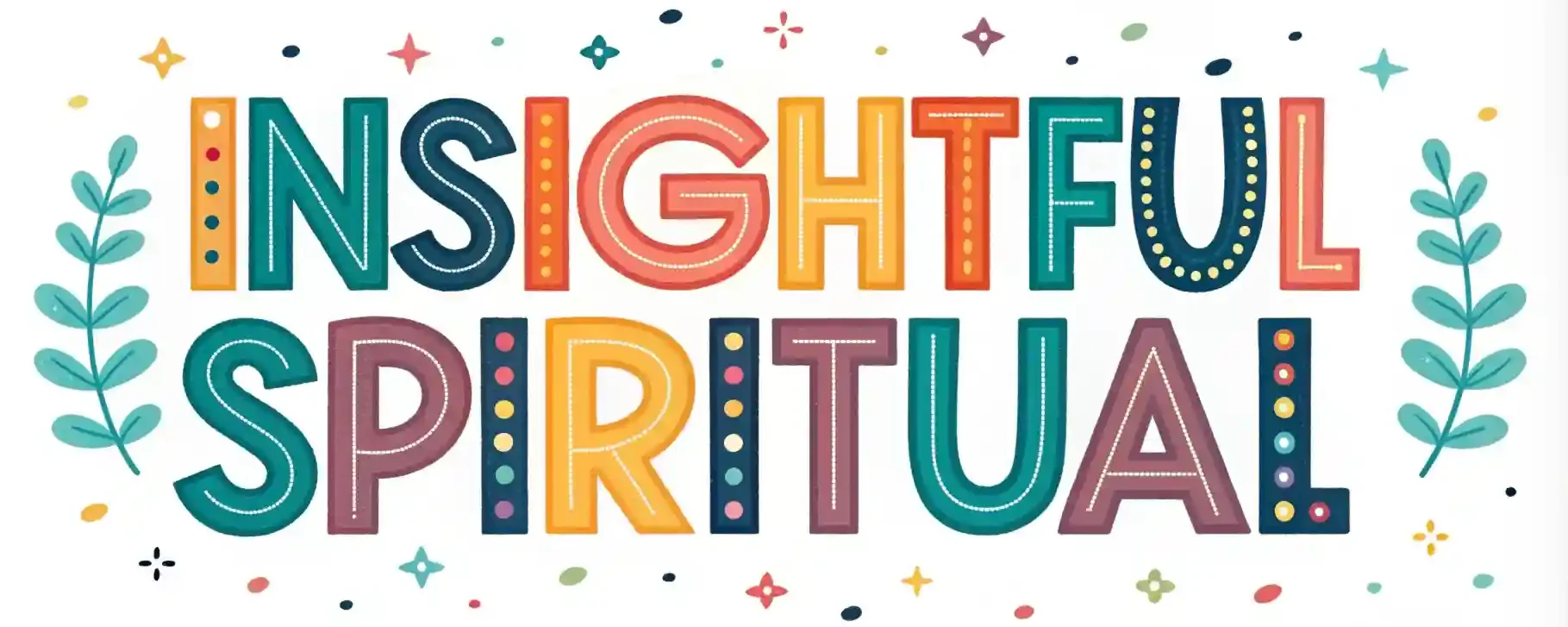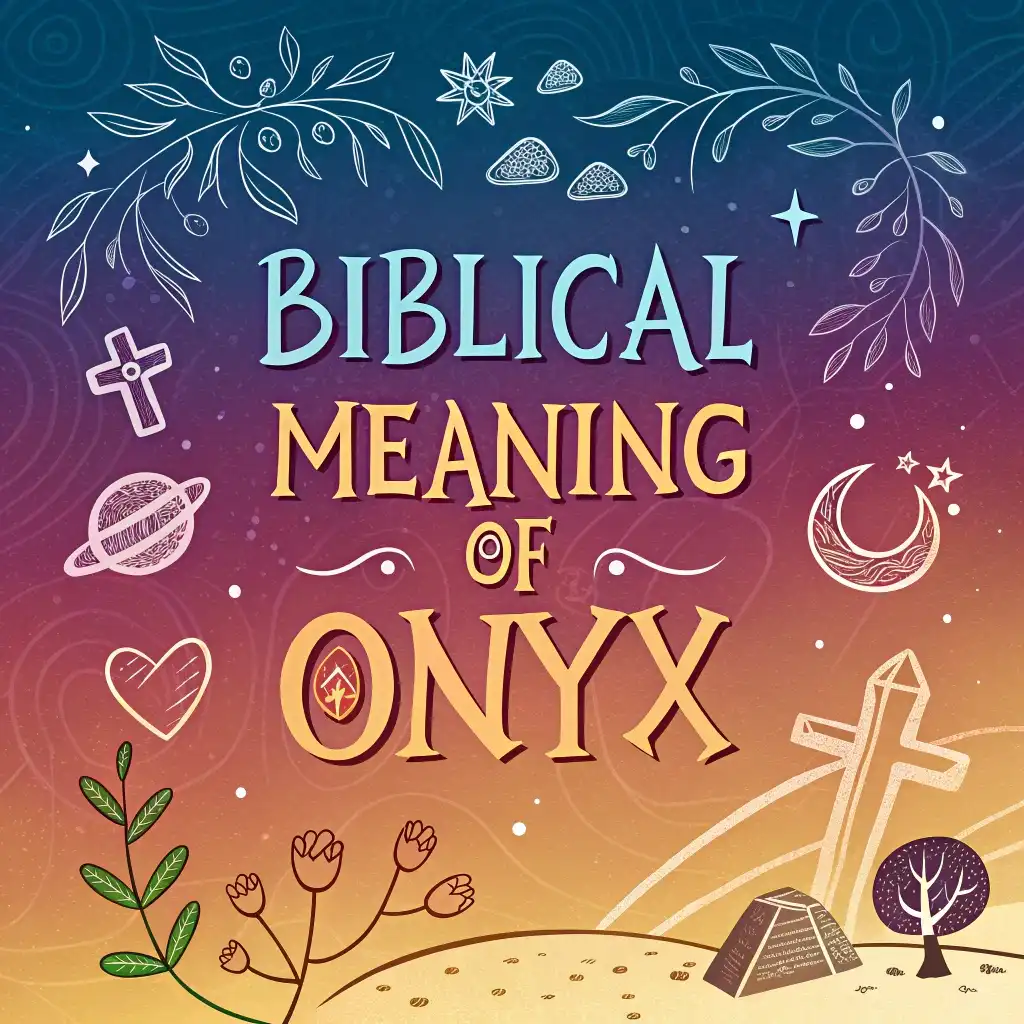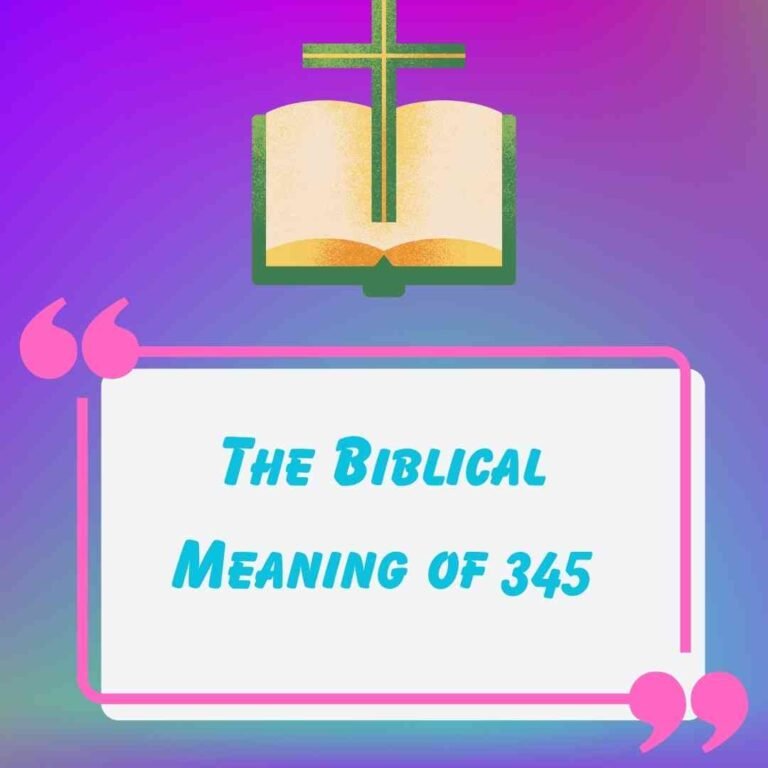Biblical Meaning of Onyx: Mystical Messages & Insights
As you explore the biblical narrative, you’ll discover that onyx holds a profound significance, symbolizing darkness, chaos, and the primordial void. This enigmatic gemstone is intricately tied to God’s judgment and wrath, its dark hue serving as a stark reminder of divine retribution.
Yet, onyx also whispers a message of redemption and atonement, echoing God’s faithful promise to restore humanity.
As you venture further into the biblical meaning of onyx, you’ll uncover a complex tapestry of contrasting themes – will you find yourself drawn to the gemstone’s mysterious allure, and the profound truths it reveals about human nature and God’s redemptive power?
In a Nutshell
- Onyx symbolizes darkness, chaos, and the primordial void, representing the raw material from which the world was shaped.
- In biblical narrative, onyx is associated with God’s judgment, wrath, and redemption, urging humanity to turn away from sin and towards righteousness.
- The gemstone is a poignant reminder of God’s covenant with His people, representing redemption and atonement, and declaring God’s power to overcome sin.
- Onyx serves as a symbol of strength and deeper understanding of God’s promise, reminding that God’s people are not defined by past mistakes.
- The gemstone represents the complexities and contradictions of human nature, echoing the duality of good and evil, light and darkness.

Onyx in the Creation Story
In many ancient cultures, you’ll find onyx embedded in the creation narratives, often symbolizing darkness, chaos, or the primordial void from which the universe emerged.
This gemstone’s presence in these stories underscores its cosmic significance, as it represents the raw material from which the world was shaped.
You’ll notice that onyx is frequently mentioned alongside other precious stones, like jasper and sapphire, which were believed to possess creative power.
In the Babylonian creation myth, Enuma Elish, onyx is associated with the primordial sea goddess, Tiamat, who embodies the chaotic forces of nature.
Similarly, in ancient Greek mythology, onyx is linked to the primordial deities, Chaos and Gaea, who gave birth to the universe.
Symbolism of Darkness and Sorrow
As you explore onyx’s significance in creation narratives, you’ll find that its association with primordial forces also leads to its symbolism of darkness and sorrow, reflecting the gemstone’s capacity to embody the unknown and the unconscious.
This somber connotation is rooted in the gemstone’s dark, mysterious appearance, which evokes feelings of melancholy and despair. In ancient cultures, onyx was often used in mourning rituals, where it served as a symbol of grief and bereavement.
The gemstone’s dark hue was seen as a representation of the shadowy veil that separates the living from the dead, a reminder of the transience of human life.
In this context, onyx’s darkness represents the unknown territories of the human psyche, where fears, anxieties, and sorrows reside.
The gemstone’s symbolism encourages you to confront and acknowledge these emotions, rather than suppressing them. By embracing the darkness, you can begin to understand the complexities of the human experience and find a path towards healing and liberation.
Through onyx’s symbolism of darkness and sorrow, you’re reminded that true freedom lies in embracing the full spectrum of human emotions, rather than attempting to escape or deny them.
God’s Judgment and Wrath
Your exploration of onyx’s significance also uncovers its association with God’s judgment and wrath, where the gemstone’s dark, mysterious essence is thought to embody the severity of divine retribution.
This connection is rooted in the biblical narrative, where onyx is mentioned alongside other precious stones in the book of Revelation, symbolizing the wrath of God poured out upon the earth.
The stone’s dark color is seen as a manifestation of God’s fiery vengeance, a reminder of the consequences of disobedience and rebellion.
As you excavate deeper into the symbolism of onyx, you’ll discover that it’s not just a representation of God’s wrath, but also a call to repentance and redemption.
The gemstone serves as a warning, urging humanity to turn away from sin and towards a path of righteousness.
In this sense, onyx embodies the dual nature of God’s judgment, which is both severe and merciful.
The Priestly Garments of Onyx
Onyx’s role in the priestly garments of the ancient Israelites offers a fascinating counterpoint to its association with God’s judgment and wrath.
In Exodus 28, God instructs Moses to create sacred garments for the high priest, Aaron, and onyx is one of the stones specified for the ephod, a vest-like garment. The ancient craftsmen carefully set the onyx stones into gold filigree, creating a breathtaking display of sacred insignia.
As you explore further, you’ll notice that onyx is paired with other precious stones, each representing a tribe of Israel.
This union of stones symbolizes the unity and harmony that God desires for His people. The onyx, in particular, serves as a poignant reminder of God’s covenant with Israel, a covenant built on faithfulness and obedience.
In this context, the onyx takes on a new significance, one that speaks to God’s desire for intimacy and connection with His people.
As you reflect on the priestly garments, you’ll see that onyx’s role isn’t just ornamental, but deeply symbolic of God’s redemptive plan.
Representation of Human Nature
What lies beneath onyx’s enigmatic surface is a profound reflection of human nature, with its dark, mysterious beauty echoing the complexities and contradictions of the human condition.
As you gaze into its depths, you’re confronted with the darkness that lies within yourself, a reminder of humanity’s inherent flaws.
This gemstone represents the inherent duality of human nature, where good and evil, light and darkness, coexist in an eternal struggle.
The onyx’s somber hue is a symbol of Original Sin, a chronicle to the imperfections that have plagued humanity since the dawn of time.
You see, human frailty is an inherent aspect of our existence, and the onyx serves as a poignant reminder of our limitations and vulnerabilities.
By acknowledging these imperfections, you can begin to understand the complexities of your own nature, and perhaps, find a path towards self-acceptance and redemption.
As you continue to explore the mysteries of onyx, you’ll discover that its darkness isn’t just a reflection of human nature, but also a catalyst for personal growth and transformation.
Contrasting Themes of Onyx
As you excavate deeper into the symbolism of onyx, it becomes apparent that this enigmatic gemstone embodies a plethora of contrasting themes that seem to defy logic, yet harmoniously coexist in a delicate balance of light and darkness.
On one hand, onyx is often associated with mourning, sorrow, and darkness, symbolizing the human experience of pain and suffering. On the other hand, it’s also linked to strength, resilience, and spiritual growth, representing the human capacity for transformation and redemption.
This spiritual dichotomy is reflected in the cultural significance of onyx across different civilizations. In ancient times, onyx was used in burial rites and mourning jewelry, signifying the darkness of death. Conversely, it was also employed in sacred rituals and ceremonies, symbolizing the light of spiritual rebirth.
This paradoxical nature of onyx resonates with the human experience, where darkness often precedes the dawn of new beginnings. As you plunge deeper into the symbolism of onyx, you’ll discover that these contrasting themes aren’t mutually exclusive, but rather, they coexist in a complex dance of light and darkness, freedom and bondage.
Onyx in the Tabernacle Design
In the biblical narrative of Exodus, onyx plays a significant role in the design of the Tabernacle, where it’s listed among the precious stones adorning the high priest‘s ephod and breastplate.
As you excavate into the details of the Tabernacle’s design, you’ll discover that onyx isn’t just a decorative element, but a symbol of divine significance. The use of onyx in the Tabernacle’s architecture reflects the ancient craftsmanship of the Israelites, who were instructed by God to build a sacred space that would house His presence.
Onyx represents strength, resilience, and spiritual growth, qualities that are essential for the high priest as he intercedes on behalf of the people.
The Tabernacle’s design, including the use of onyx, is a reflection of God’s divine plan and purpose for His people.
The intricate craftsmanship required to set the onyx stones into the ephod and breastplate testifies to the skill and dedication of the Israelite artisans.
As you explore the significance of onyx in the Tabernacle, you’ll gain a deeper understanding of the biblical narrative and the symbolism behind this precious stone.
Redemption Through Onyx
Through its presence in the high priest’s breastplate, onyx serves as a tangible reminder of God’s covenant with His people, symbolizing redemption and atonement.
As you explore into the significance of onyx, you’ll discover that it represents the faith testing you’ve endured, where your trust in God was pushed to the limits. Yet, it’s in these trying times that you’ve emerged stronger, with a deeper understanding of His promise to overcome sin.
You see, onyx is more than just a precious stone; it’s a symbol of God’s faithfulness to redeem and restore. It’s a reminder that, despite your shortcomings, you’re not defined by your past mistakes.
Onyx stands as a declaration to God’s power to overcome sin, liberating you from its grasp. As you reflect on the onyx’s presence in the breastplate, you’re reminded that you’re part of a larger narrative – one of redemption and freedom.
You’re not alone in your struggles; God has been faithful to His people throughout history, and He’ll continue to be faithful to you. Through onyx, you’re invited to experience the depth of God’s redemption, where your faith is refined, and your heart is set free.
Frequently Asked Questions
Is Onyx a Precious Stone in Biblical Times?
You explore ancient trading routes, discovering onyx was a coveted gemstone, often used in royal adornment, and considered precious due to its rarity and unique banding patterns, making it a valuable commodity in ancient economies.
What Is the Spiritual Significance of Black Onyx?
As you explore the spiritual significance of black onyx, you’ll find it’s often associated with dark magic, yet, paradoxically, it’s believed to facilitate soul purification, allowing you to transcend negativity and reveal your true potential, ultimately granting you spiritual freedom.
Can Onyx Stones Be Used for Healing Purposes?
You can utilize onyx stones for healing by harnessing their energy to balance and align your chakras, promoting emotional stability and clarity, allowing you to break free from negativity and tap into your full potential.
Are Onyx Stones Mentioned in Other Religious Texts?
You’ll find onyx stones mentioned in various religious texts beyond the Bible, such as in Hindu mythology, where it’s associated with Lord Vishnu, and in Sumerian lore, where it symbolizes strength and fertility.
Is Onyx a Popular Choice for Modern Jewelry Designs?
You’ll find onyx stones in many modern jewelry designs, particularly in trendy accessories and statement pieces, as its sleek, dark beauty adds an edgy touch to any outfit, making it a sought-after choice for fashion enthusiasts.

Hi, I’m Aurelia Starfrost, your spiritual guide at InsightfulSpiritual.com. I love exploring ancient wisdom and modern practices to help you on your journey. With a focus on meditation and energy healing, I’m here to guide you to find solace within and discover your spiritual essence.







